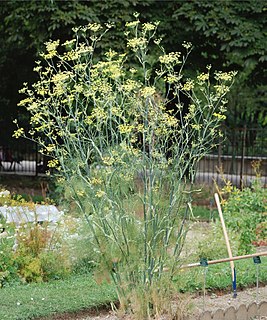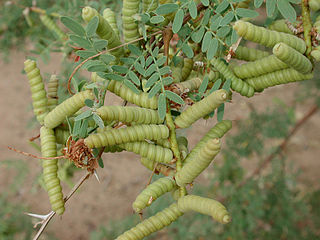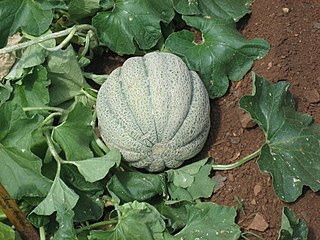
Cucumber is a widely cultivated plant in the gourd family, Cucurbitaceae. It is a creeping vine that bears cucumiform fruits that are used as vegetables. There are three main varieties of cucumber: slicing, pickling, and seedless. Within these varieties, several cultivars have been created. In North America, the term "wild cucumber" refers to plants in the genera Echinocystis and Marah, but these are not closely related. The cucumber is originally from South Asia, but now grows on most continents. Many different types of cucumber are traded on the global market.

Fennel is a flowering plant species in the carrot family. It is a hardy, perennial herb with yellow flowers and feathery leaves. It is indigenous to the shores of the Mediterranean but has become widely naturalized in many parts of the world, especially on dry soils near the sea-coast and on riverbanks.

A pest is any animal or plant detrimental to humans or human concerns, including crops, livestock, and forestry. The term is also used of organisms that cause a nuisance, such as in the home. An older usage is of a deadly epidemic disease, specifically plague. In its broadest sense, a pest is a competitor of humanity.

Australian limes are species of the plant genus Citrus that are native to Australia and Papua New Guinea.

Mesquite is a common name for several plants in the genus Prosopis, which contains over 40 species of small leguminous trees. They are native to the southwestern United States and Mexico.
The mesquite originates in the Tamaulipan mezquital ecoregion, in the deserts and xeric shrublands biome, located in the southern United States and northeastern Mexico. It has extremely long roots in order to seek water from very far underground. The region covers an area of 141,500 km2, encompassing a portion of the Gulf Coastal Plain in southern Texas, northern Tamaulipas, northeastern Coahuila, and part of Nuevo León. As a legume, mesquite is one of the few sources of fixed nitrogen in the desert habitat.

Passiflora foetida is a species of passion flower that is native to the southwestern United States, Mexico, the Caribbean, Central America, and much of South America. It has been introduced to tropical regions around the world, such as Southeast Asia, South Asia, and Hawaii. It is a creeping vine like other members of the genus, and yields an edible fruit. The specific epithet, foetida, means "stinking" in Latin and refers to the strong aroma emitted by damaged foliage.

Cucumis metuliferus, horned melon, spiked melon, or kiwano, also African horned cucumber or melon, jelly melon, hedged gourd, melano, is an annual vine in the cucumber and melon family, Cucurbitaceae. Its fruit has horn-like spines, hence the name "horned melon". Ripe fruit has orange skin and lime green, jelly-like flesh with a refreshingly fruity taste, and texture similar to a passionfruit or pomegranate. C. metuliferus is native to Sub-Saharan Africa. It is now grown in the United States, Portugal, Italy, Germany, Chile, Australia, and New Zealand.

Coccinia grandis, the ivy gourd, also known as scarlet gourd, tindora, and kowai fruit, is a tropical vine. It grows primarily in tropical climates and is commonly found in the southern Indian state of Kerala, where it forms a part of the local cuisine. Coccinia grandis is cooked as a vegetable.

Annona glabra is a tropical fruit tree in the family Annonaceae, in the same genus as the Soursop and Cherimoya. Common names include pond apple, alligator apple, swamp apple, corkwood, bobwood, and monkey apple. The tree is native to Florida in the United States, the Caribbean, Central and South America, and West Africa. It is common in the Everglades. The A. glabra tree is considered an invasive species in Sri Lanka and Australia. It grows in swamps, is tolerant of saltwater, and cannot grow in dry soil.

Melocactus, also known as the Turk's cap cactus, is a genus of cactus with about 30–40 species. They are native to the Caribbean, western Mexico through Central America to northern South America, with some species along the Andes down to southern Peru, and a concentration of species in northeastern Brazil.

In the flowering plants, an ovary is a part of the female reproductive organ of the flower or gynoecium. Specifically, it is the part of the pistil which holds the ovule(s) and is located above or below or at the point of connection with the base of the petals and sepals. The pistil may be made up of one carpel or of several fused carpels, and therefore the ovary can contain part of one carpel or parts of several fused carpels. Above the ovary is the style and the stigma, which is where the pollen lands and germinates to grow down through the style to the ovary, and, for each individual pollen grain, to fertilize one individual ovule. Some wind pollinated flowers have much reduced and modified ovaries.

Solanum muricatum is a species of evergreen shrub native to South America and grown for its sweet edible fruit.

Clidemia hirta, commonly called soapbush or Koster's curse, is a perennial shrub. It is an invasive plant species in many tropical regions of the world, creating serious damage.

Acanthosicyos horridus is an unusual melon that occurs only in Namibia; it is locally called naras or nara. It is a dioecious plant found in sand desert but not stony plains, in areas with access to ground water such as ephemeral rivers and paleochannels, where sand accumulating in the shelter of its stems can form hummocks up to 1000–1500 m2 in area and 4 meters in height. Its stems may rise more than a meter above the hummocks, while its system of thick taproots can extend up to 50 m downward. The nara plant is leafless, so modified stems and spines 2–3 centimeters long serve as the photosynthetic "organs" of the plant. The plant can survive many years without water.

Citrullus lanatus is a plant species in the family Cucurbitaceae, a vine-like flowering plant originating in West Africa. It is cultivated for its fruit. The subdivision of this species into two varieties, watermelons and citron melons, originated with the erroneous synonymization of Citrullus lanatus (Thunb.) Matsum. & Nakai and Citrullus vulgaris Schrad. by L.H. Bailey in 1930. Molecular data including sequences from the original collection of Thunberg and other relevant type material, show that the sweet watermelon and the bitter wooly melon Citrullus lanatus (Thunb.) Matsum. & Nakai are not closely related to each other. Since 1930, thousands of papers have misapplied the name Citrullus lanatus (Thunb.) Matsum. & Nakai for the watermelon, and a proposal to conserve the name with this meaning was accepted by the relevant nomenclatural committee and confirmed at the International Botanical Congress in Shenzhen in China in 2017.

Muskmelon is a species of melon that has been developed into many cultivated varieties. These include smooth-skinned varieties such as honeydew, Crenshaw, and casaba, and different netted cultivars. The Armenian cucumber is also a variety of muskmelon, but its shape, taste, and culinary uses more closely resemble those of a cucumber. The large number of cultivars in this species approaches that found in wild cabbage, though morphological variation is not as extensive. It is a fruit of a type called pepo.
Paddy melon is a common name for two species of plants in the melon family which are invasive in Australia:


















